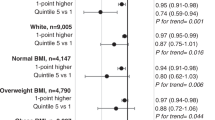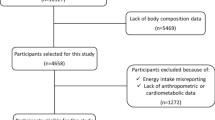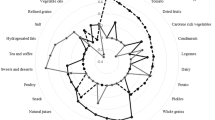Abstract
Objective: To ascertain whether simple dietary advice to increase the consumption of Mediterranean foods, given in a clinical setting, leads to reduced mortality after a myocardial infarction.
Design: Data were used from the GISSI-Prevenzione clinical trial, analysed as a cohort study with adjustment for treatment allocation.
Setting: A total of 172 centres in Italy.
Subjects: A total of 11 323 men and women with myocardial infarction. All subjects received advice to increase their consumption of fish, fruit, raw and cooked vegetables and olive oil.
Measurements: The intakes of the five foods were assessed at baseline, 6, 18 and 42 months. Associations of food intakes, a combined dietary score, and the risk of death over 6.5 y were estimated adjusting for several non-dietary variables, using pooled logistic regression.
Results: Subjects generally improved their diet according to the advice given. All foods were associated with a significant reduction in risk of death. Compared with people in the worst dietary score quarter, the odds ratio for those in the best score quarter was 0.51 (95% CI 0.44–0.59). A good diet had a protective effect in sub-groups defined by age, sex, smoking, randomized treatment and concomitant drug therapy.
Conclusions: Myocardial infarction patients can respond positively to simple dietary advice, and this can be expected to lead to a substantial reduction in the risk of early death. Regardless of any drug treatment prescribed, clinicians should routinely advise patients with myocardial infarction to increase their frequency of consumption of Mediterranean foods.
This is a preview of subscription content, access via your institution
Access options
Subscribe to this journal
Receive 12 print issues and online access
$259.00 per year
only $21.58 per issue
Buy this article
- Purchase on Springer Link
- Instant access to full article PDF
Prices may be subject to local taxes which are calculated during checkout



Similar content being viewed by others
References
Allison, PD (1995). Survival analysis using the SAS System, a practical guide, Cary, NC: SAS Institute Inc
Alpha-Tocopherol, Beta Carotene Cancer Prevention Study Group (1994). The effect of vitamin E and beta carotene on the incidence of lung cancer and other cancers in male smokers. New Engl. J. Med., 330, 1029–1035.
Artaud-Wild, SM, Connor, SL, Sexton, G & Connor, WE (1993). Differences in coronary mortality can be explained by differences in cholesterol and saturated fat intakes in 40 countries but not in France and Finland: a paradox. Circulation, 88, 771–779.
Brown, BG, Zhao, X-Q & Chait, A et al (2001). Simvastatin and niacin, antioxidant vitamins, or the combination for the prevention of coronary disease. New Engl. J. Med., 345, 1583–1592.
Burr, ML, Fehily, AM & Gilbert, JF et al (1989). Effect of changes in fat, fish, and fiber intakes on death and myocardial reinfarction: Diet and Reinfarction Trial (DART). Lancet, 2, 757–731.
Collaborative Group of the Primary Prevention Project (2001). Low-dose aspirin and vitamin E in people at cardiovascular risk: a randomized trial in general practice. Lancet, 357, 89–95.
Cupples, LA, D'Agostino, RB, Anderson, K & Kannel, WB (1988). Comparison of baseline and repeated measure covariate techniques in the Framingham Heart Study. Stats. Med., 7, 205–218.
Dagenais, GR, Marchioli, R, Yusuf, S & Tognoni, G (2000). Beta-carotene, vitamin C, and vitamin E and cardiovascular diseases. Curr. Cardiol. Rep., 2, 293–299.
de Lorgeril, M, Salen, P, Martin, J-L, Monjaud, I, Delaye, J & Mamelle, N (1999). Mediterranean diet, traditional risk factors, and the rate of cardiovascular complications after myocardial infarction: final report of the Lyon Diet Heart Study. Circulation, 99, (6) 779–785.
Fernandez-Jarne, E, Martinez-Losa, E, Prado-Santamaria, M, Brugarolas-Brufau, C, Serrano-Martinez, M & Martinez-Gonzales, MA (2002). Risk of first non-fatal myocardial infarction negatively associated with olive oil consumption: a case–control study in Spain. Int. J. Epidemiol., 31, 474–480.
GISSI-Prevenzione Investigators (1999). Dietary supplementation with n-3 polyunsaturated fatty acids and vitamin E after myocardial infarction: results of the GISSI-Prevenzione trial. Lancet, 354, 447–455.
Hennekens, CH, Buring, JE & Manson, JE et al (1996). Lack of effect of long-term supplementation with beta-carotene on the incidence of malignant neoplasms and cardiovascular disease. New Engl. J. Med., 334, 1145–1149.
Hooper, L, Summerbell, CD, Higgins, JPT, Thompson, RL, Capps, NE, Smith, GD, Riemersma, RA & Ebrahim, S (2001). Dietary fat intake and prevention of cardiovascular disease: systematic review. Br. Med. J., 31, 757–763.
HOPE (Heart Outcomes Prevention Evaluation) Study Investigators (2000). Vitamin E supplementation and cardiovascular events in high-risk patients. N. Engl. J. Med., 342, 154–160.
Hu, FB, Stampfer, MJ, Manson, JE, Rimm, E, Colditz, GA, Rosner, BA, Hennekens, CH & Willett, WC (1997). Dietary fat intake and the risk of coronary heart disease in women. New Engl. J. Med., 337, 1491–1499.
Hu, FB, Stampfer, MJ, Rimm, E, Ascherio, A, Rosner, BA, Spielgeman, D & Willet, WC (1999). Dietary fat and coronary heart disease: a comparison of approaches for adjusting for total energy intake and modelling repeated dietary measurements. Am. Journal Epidemiol., 149, 531–540.
Joshipura, KJ, Hu, FB, Manson, JE, Stampfer, MJ, Rimm, EB, Speizer, FE, Colditz, G, Ascherio, A, Rosner, B, Spielgman, D & Willet, WC (2001). The effect of fruit and vegetables intake on risk for coronary heart disease. Ann. Intern. Med., 134, 1106–1114.
Keys, A (1970). Coronary heart disease in seven countries. Circulation, 41, (Suppl I) I-1–I-211.
Khaw, KT & Barrett-Connor, E (1987a). Dietary fibre and reduced ischaemic heart disease mortality rates in men and women: a 12 year prospective study. Am. J. Epidemiol., 126, 1093–1102.
Khaw, KT & Barrett-Connor, E (1987b). Dietary potassium and stroke-associated mortality: a 12-year prospective population study. New Engl. J. Med., 316, 235–240.
Knekt, P, Reunanen, A, Jarvinen, R, Seppanen, R, Hellovaara, M & Arommaa, A (1994). Antioxidant vitamin intake and coronary mortality in a longitudinal study. Am. J. Epidemiol., 139, 180–189.
Knekt, P, Jarviven, R, Reunanen, A & Maatela, J (1996). Flavonoid intake and coronary mortality in Finland: a cohort study. Br. Med. J., 312, 478–481.
Krauss, RM, Eckel, RH & Howard, B et al (2000). AHA Dietary Guidelines Revision 2000. A Statement for Healthcare Professionals From the Nutrition Committee of the American Heart Association. Circulation, 102, 2296–2311.
Marchioli, R (1999). Antioxidant vitamins and prevention of cardiovascular disease: Laboratory, epidemiological and clinical trial data. Pharmac. Res., 40, 227–238.
Marchioli, R (2001). Vitamin E and cardiovascular disease. Thromb. Haemost., 85, 758–760.
Marchioli, R, Avanzini, F, Barzi, F, Chieffo, C, Di Castelnuovo, A, Franzosi, MG, Geraci, E, Maggioni, AP, Marfisi, RM, Mininni, N, Nicolosi, GL, Santini, M, Schweiger, C, Gavazzi, L, Tognoni, G & Valagussa, F on behalf of GISSI-Prevenzione Investigators (2001). An Italian Coronary Risk Chart for patients with recent myocardial infarction: Results of the GISSI-Prevenzione Study. Eur. Heart J., 22, 2085–2103.
MRC/BHF Heart Protection Study Collaborative Group (1999). MRC/BHF Heart Protection Study of cholesterol-lowering therapy and of antioxidant vitamin supplementation in a wide range of patients at increased risk of coronary heart disease death: early safety and efficacy experience. Eur. Heart J., 20, 725–741.
Ness, AR & Powles, JW (1997). Fruit and vegetables, and cardiovascular disease: a review. Int. J. Epidemiol., 26, 1–13.
Omenn, GS (1995). What accounts for the association of vegetables and fruit with lower incidence of cancers and coronary heart disease?. Ann Epidemiol., 5, 333–335.
Omenn, GS, Goodman, GE & Thornquist, MD et al (1996). Effects of beta-carotene and vitamin A on lung cancer and cardiovascular disease. New Engl. J. Med., 334, 1150–1155.
Pietinen, P, Ascherio, A, Korhonen, P, Hartman, AM, Willett, WC, Albanes, D & Virtamo, J (1997). Intake of fatty acids and risk of coronary heart disease in a cohort of Finnish men: the Alpha-Tocopherol, Beta-Carotene Cancer Preventive Study. Am. J. Epidemiol, 145, 1876–1887.
Rimm, EB, Stampfer, MJ, Ascherio, A, Giovannucci, E, Colditz, GA & Willett, WC (1993). Vitamin E consumption and the risk of coronary heart disease in men. New Engl. J. Med., 328, 1450–1456.
Rimm, EB, Ascherio, A, Giovannucci, E, Spiegelman, D, Stampfer, MJ & Willett, WC (1996). Vegetable, fruit and cereal fiber intake and risk of coronary heart disease among men. JAMA, 275, 447–451.
Sans, S, Kesteloot, H & Kromhout, D on behalf of the Task Force of the European Society of Cardiology on Cardiovascular Mortality and Morbidity Statistics in Europe (1997). The burden of cardiovascular diseases mortality in Europe. Eur. Heart. J., 18, 1231–1248.
Serra-Majem, L, Ribas, L, Lloveras, G & Salleras, L (1993). Changing patterns of fat consumption in Spain. Eur. J. Clin. Nutr., 47, (Suppl, 1) S13–S20.
Stampfer, MJ, Hennekens, CH, Manson, JE, Colditz, GA, Rosner, B & Willett, WC (1993). Vitamin E consumption and the risk of coronary disease in women. New Engl. J. Med., 328, 1444–1449.
Stampfer, MJ, Hu, FB, Manson, JE, Rimm, EB & Willet, WC (2000). Primary prevention of coronary heart disease in women through diet and lifestyle. New Engl. J. Med., 343, 16–22.
Todd, S, Woodward, M, Tunstall-Pedoe, H & Bolton-Smith, C (1999). Dietary antioxidant vitamins and fiber in the etiology of cardiovascular disease and all-causes mortality: results from the Scottish Health Study. Am. J. Epidemiol, 150, 1073–1080.
Woodward, M (1999). Epidemiology: Study Design and Data Analysis, Boca Raton, FL: Chapman and Hall/CRC
Acknowledgements
GISSI is endorsed by Associazione Nazionale Medici Cardiologi Ospedalieri (ANMCO), Firenze, Italy and by Istituto di Ricerche Farmacologiche Mario Negri, Consorzio Mario Negri Sud, Santa Maria Imbaro, Italy. GISSI-Prevenzione was supported by Bristol-Myers Squibb, Pharmacia-Upjohn, Societá Prodotti Antibiotici, Pfizer and Bracco. We thank C Pera, B Ferri, A Flamminio, A Polidoro and R Zama for invaluable secretarial help during the course of the study. Federica Barzi was the recipient of a research fellowship from Instituto di Ricerche Farmacologiche M. Negri, Milano, Italy.
Author information
Authors and Affiliations
Consortia
Contributions
Guarantor: F Barzi.
Contributors: BF was responsible for the data analysis and statistical expertise. MW was responsible for statistical expertise and supervision. RMM contributed to data analysis and statistical expertise. LT contributed to conception and design, to obtain funding and supervision. GT was responsible for conception and design and supervision. FV contributed to conception and design and was responsible for obtaining funding. RM was responsible for conception and design, acquisition of data and supervision. All the authors contributed to manuscript editing.
Corresponding author
Appendix
Appendix
Let the food frequency recorded at the ith visit (i=1, 2, 3, 4) be Di. Let the time between the ith and the i+1th visit be Ti (i=1,2,3) and let T4 be the time from the last visit to the end of follow-up (death or censoring). The food consumption Cj (j=1,2,3,4) for the jth time interval was calculated as: Cj=j=1, 2, 3, 4.

When Di was missing it was estimated by the most recent non-missing value of D (i.e. last information carried forward).
Rights and permissions
About this article
Cite this article
Barzi, F., Woodward, M., Marfisi, R. et al. Mediterranean diet and all-causes mortality after myocardial infarction: results from the GISSI-Prevenzione trial. Eur J Clin Nutr 57, 604–611 (2003). https://doi.org/10.1038/sj.ejcn.1601575
Received:
Revised:
Accepted:
Published:
Issue Date:
DOI: https://doi.org/10.1038/sj.ejcn.1601575
Keywords
This article is cited by
-
Mediterranean Diet and Obesity-related Disorders: What is the Evidence?
Current Obesity Reports (2022)
-
Olive leaf extract supplementation improves the vascular and metabolic alterations associated with aging in Wistar rats
Scientific Reports (2021)
-
Long-term dietary adherence and changes in dietary intake in coronary patients after intervention with a Mediterranean diet or a low-fat diet: the CORDIOPREV randomized trial
European Journal of Nutrition (2020)
-
The effects of a lifestyle-focused text-messaging intervention on adherence to dietary guideline recommendations in patients with coronary heart disease: an analysis of the TEXT ME study
International Journal of Behavioral Nutrition and Physical Activity (2018)
-
Mediterranean diet and prognosis of first-diagnosed Acute Coronary Syndrome patients according to heart failure phenotype: Hellenic Heart Failure Study
European Journal of Clinical Nutrition (2017)



